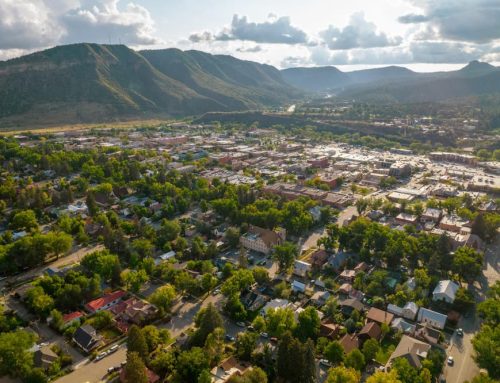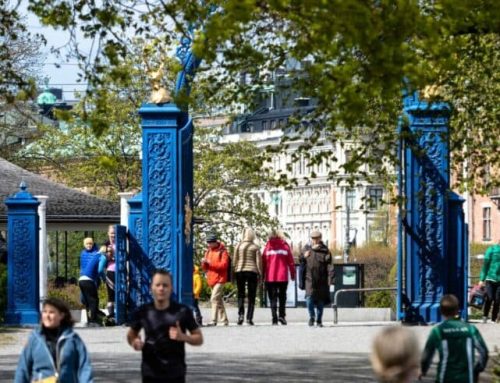Destination Stewardship Report – Spring 2021 (Volume 1, Issue 4)
This post is from the Destination Stewardship Report (Spring 2021, Volume 1, Issue 4), an e-quarterly publication that provides practical information and insights useful to anyone whose work or interests involve improving destination stewardship in a post-pandemic world.
How to present an indigenous culture “written in the land” to tourists? Along with Laura Hope, communications manager at Coast Funds, Bert Mercer, economic development manager for Nisg̱a’a Lisims Government, describes the process of tying together a culturally sensitive tourism experience for visitors to the Nisga’a First Nation in British Columbia, Canada.
The Nisga’a Offer an Indigenous Tourism Model
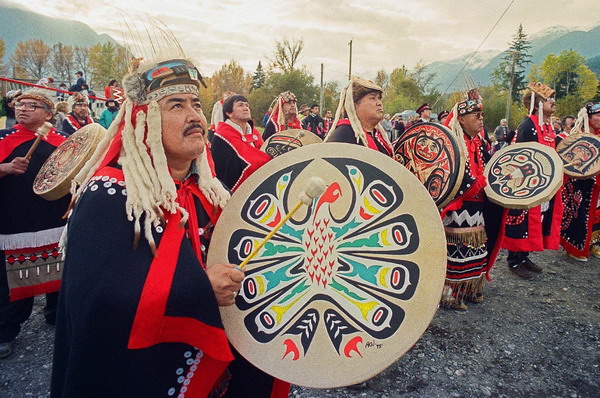
Nisga’a chiefs, elders, matriarchs, youth, and guests celebrate the raising of a Pts’aan (totem pole) in Gitwinksihlkw. Photo by Gary Fiegehen, courtesy of Nisga’a Lisims Government.
Written on the Land—Weaving Together a Cultural Tourism Story
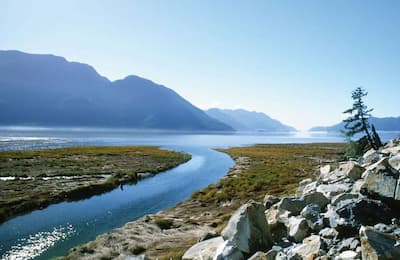
The plentiful resources of the Nass Valley have supported Nisg̱a’a citizens for millennia. Photo: Gary Fiegehen, courtesy of Nisga’a Lisims Government.
The Nisg̲a’a Highway, running through the heart of our Nation’s lands in Canada’s rugged northwest coast, was given the numeric designation 113. The number was not chosen arbitrarily; between 1887, when Nisg̲a’a chiefs travelled to Victoria to demand recognition of Title, and 2000, when the Nisg̲a’a Treaty was ratified and the Nisg̱a’a Lisims Government passed its first law, exactly 113 years had passed. Over the next five years, our government extended and upgraded the highway, connecting the four Nisg̱a’a villages and inviting the world to visit.
The lands and waters of my First Nation, encompassing 200,000 hectares from the K’alii Aksim Lisims (the Nass River) to the Hazelton Mountains is astounding in its beauty. It is a place of aquamarine waters, soaring snow-capped mountains, and an enormous lava field. The story of our people is written on the land, so visitors to our lands are offered more than breathtaking scenery—they are offered the opportunity to experience Nisg̱a’a culture.
Bringing Cultural Tourism to the Nass Valley
Visitors to the Nass Valley are greeted by Txeemsim, a super-natural being who brought light to the Nass River in a time when Nisg̲a’a lived in semi-darkness. His image is the centrepiece of the Nisg̱a’a cultural marketing and tourism initiative. The initiative was expanded and enhanced to develop an auto-tour route along the Nisg̲a’a Highway, in addition to a brochure to guide visitors along the route and a website devoted solely to tourism in Nisg̲a’a lands. The project and the partnerships that developed as a result have boosted tourism in the Nass Valley, raised the profile of entrepreneurs in the four Nisg̲a’a villages, and reinforced the sovereignty and culture of the Nisg̲a’a Nation.
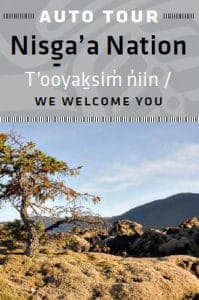
The land, with its storied and scenic landscape, is a perfect fit for a tourism initiative. And tourism, with its many cultural and economic benefits, is an ideal undertaking to pursue.
As economic development manager for the Nisg̱a’a Lisims Government, it has been my job to develop our tourism industry. According to a 2019 report, the Indigenous tourism sector is outpacing Canadian tourism activity overall. The direct economic benefits of the Indigenous tourism sector was valued at $1.7 billion in 2017, having grown 23% over the previous three years.
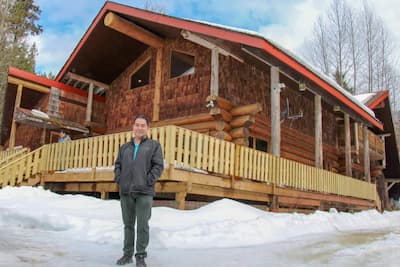
Bert Mercer, economic development manager for the Nisg̱a’a Lisims Government stands in front of the newly opened Vetter Falls Lodge. Photo by Laura Hope.
The whole idea of the cultural tourism initiative was to draw people into the Nass Valley. We had a number of tourism elements in place throughout the valley—a volcano tour, the Nisg̱a’a Museum, our hot springs, and a unique and culturally rich landscape—we just had to package everything together.
The centrepiece of the initiative, an 18-stop auto-tour along 100 kilometres of the Nass Valley, takes visitors to culturally significant stops, all within an easy walk of the Nisg̱a’a Highway. The auto-tour signs create driver awareness by improving wayfinding, stimulating interest in our culture, and providing visitors with cultural, social, and geographic interpretations of our lands.
By tying all the attractions together in this way, we can welcome visitors to stay longer. We can point them to local accommodations—like Vetter Falls Lodge—and local places of significance. We want visitors to get to know, and fall in love with, Nisg̱a’a lands.
The Nisg̱a’a tourism and marketing initiative exemplifies Indigenous cultural tourism, the symbiotic relationship between visitors who want to have an authentic cultural experience and First Nations like ours, who want to share and strengthen our culture.
Lessons Learned
Government Dynamics: I’m proud of the work I’ve done for our government in developing the cultural tourism initiative to bring visitors into the Nass Valley, but the project has faced its share of challenges along the way.
One of the more challenging aspects was working to ensure that the initiative reflected the vision of each of the four Nisg̱a’a villages. Though I work for our central Nisg̱a’a Lisims Government, early on I began working closely with the governments of the four villages to develop and approve the auto-tour and brochure.
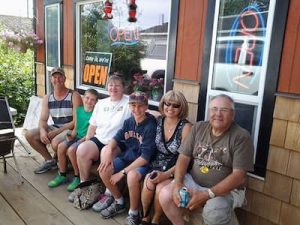
Tourists outside of Bonnie Stanley’s U See Food U Eat it restaurant in Gingolx. The restaurant is gaining international recognition; visitors are starting to return each summer from Europe. Photo: Laura Hope
One of the keys to success has been developing a steering committee consisting of representatives from Nisg̱a’a Lisims Government and each of the four villages. We developed a terms of reference for the committee that clearly outlined its scope, what kind of recommendations it can provide to leadership, and what types of projects it can become involved in.
If I were starting this project over again, I’d put my steering committee in place right from the very beginning, even before planning with a consultant. They are the stakeholders and can help overcome the siloed nature of government structures.
Importance of Branding: In order to establish Nisg̱a’a Tourism as an international-quality product, I worked closely to follow the established brand guidelines of our government. The government designer, Jim Skipp, always reinforced that following brand guidelines is of the utmost importance and can really lend strength to a tourism initiative.
Cultural Sensitivities: I also worked closely with our elders to ensure the Nisg̱a’a language was responsibly incorporated. Though the process took time, it was so important to include the language and cultural interpretations into the auto-tour. Providing wider access to culturally significant sites like the hot springs, and the lava bed memorial park required careful thought and planning.
The hot springs are increasingly becoming a destination for outside visitors and we have to manage that impact with a desire to protect our cultural sites.
Allowing Room for Growth: The auto-tour and brochure were purposefully designed to allow for growth of tourism in the region. We knew we’d be opening Vetter Falls Lodge—owned and operated by the Nisg̱a’a Lisims Government—and wanted to make sure we could add that to the printing of the auto-tour brochure.
The COVID-19 pandemic has paused tourism across the world. Here in the Nass Valley we are using this time to thoughtfully prepare for local tourism in the coming year when our Nation is ready again for visitors. We look forward to a time in the near future when we can once again welcome the world to our home.
Learn more about the Nisg̱a’a Cultural Tourism Initiative at coastfunds.ca
About the Author
Bert Mercer is the economic development manager for the Nisga’a Lisims Government, a First Nation in British Columbia, Canada.


